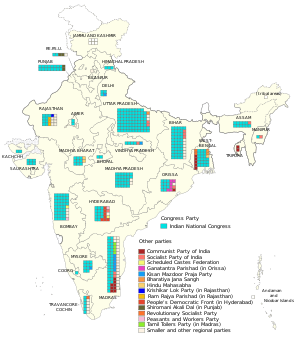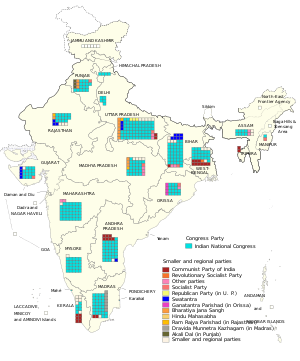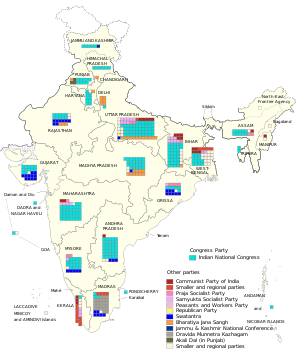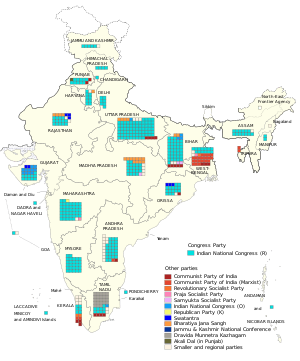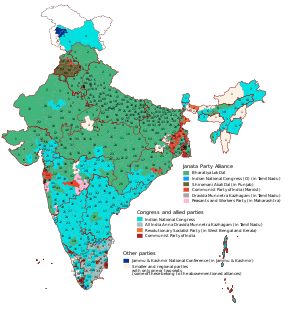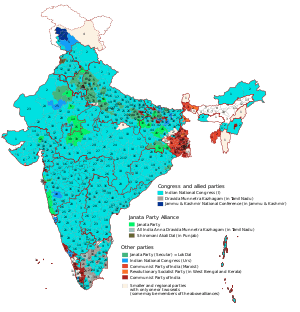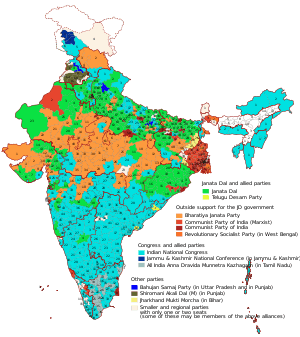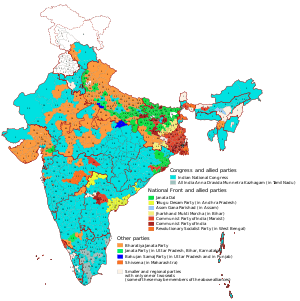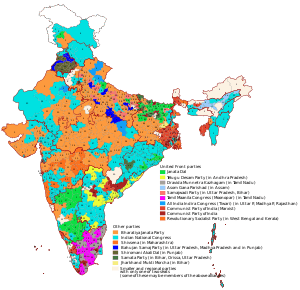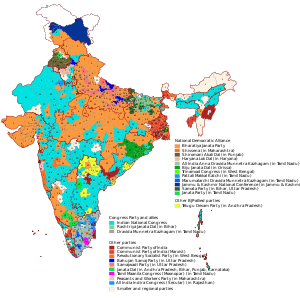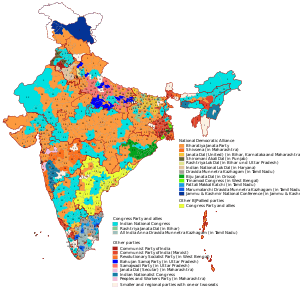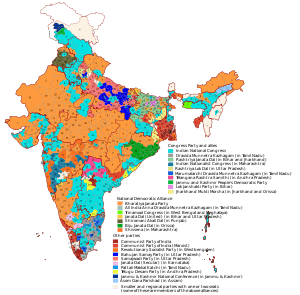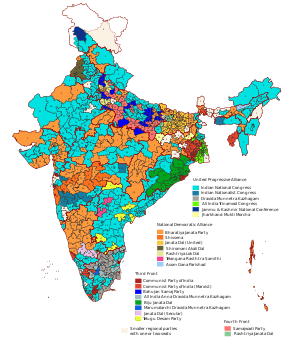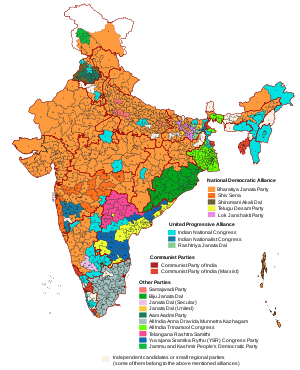Elections in India
India is a country, divided in states and union territories, with a parliamentary system governed under the Constitution of India, which defines the power distribution among the federal government and the states.
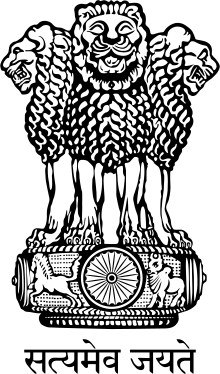 |
|---|
| This article is part of a series on the politics and government of India |
|
National coalitions
|
|
|
The President of India is the ceremonial head of the country and supreme commander-in-chief for all defence forces in India.[1]
However, it is the Prime Minister of India, who is the leader of the party or political alliance having a majority in the national elections to the Lok Sabha, that exercises most executive powers for matters that require countrywide affection under a federal system.
India is regionally divided into States (and Union Territories) and each State has a Chief Minister who is the leader of the party or political alliance having won majority in the regional elections otherwise known as State Assembly Elections that exercises executive powers in that State. The respective State's Chief Minister has executive powers within the State and works jointly with the Prime Minister of India or his ministers on matters that require both State and Central attention. Some Union Territories also elect an Assembly and have a territorial government and other (mainly smaller) Union Territories are governed by a person appointed by the President of India.
The President of India monitors the rule of law through his appointed governors in each State and on their recommendation can take over the executive powers from the Chief Minister of the State, temporarily when the elected representatives of the State government has failed to create a peaceful environment and has deteriorated into chaos. The President of India dissolves the existing State government if necessary, and a new election is conducted.
Election Commission
Election Commission is a federal body, enacted under the provisions of the Constitution, responsible for monitoring and administering all the electoral processes of India. This body is responsible for ensuring elections are free and fair, without any bias.[2]
Election Commission ensures the conduct of members pre-elections, during elections and post-elections are as per the statutory legislation.
All election related disputes are handled by the Election Commission. The Supreme Court of India has held that where the enacted laws are silent or make insufficient provision to deal with a given situation in the conduct of elections, the Election Commission has the residuary powers under the Constitution to act in appropriate manner.
Types of Elections
Elections in the Republic of India include elections for :
- Members of the Parliament in Lok Sabha and Rajya Sabha,
- Members of State Legislative Assemblies, (and also Assembly elections to some of the Union Territories like Delhi),
- Members of State Legislative Councils,
- Members in village panchayats or city corporation councils.
- By-election is held when a person of a particular constituent dies, resigns, or is disqualified.
General Elections (Lok Sabha)
Members of Lok Sabha (House of the People) or the lower house of India's Parliament are elected by being voted upon by all adult citizens of India, from a set of candidates who stand in their respective constituencies. Every adult citizen of India can vote only in their constituency. Candidates who win the Lok Sabha elections are called 'Member of Parliament' and hold their seats for five years or until the body is dissolved by the President on the advice of the council of ministers. The house meets in the Lok Sabha Chambers of the Sansad Bhavan in New Delhi, on matters relating to creation of new laws, removing or improving the existing laws that affect all citizens of India. Elections take place once in 5 years to elect 545 members for the Lok Sabha (Lower house). [3]
History of Lok Sabha Elections
- Key
All India Anna Dravida Munnetra Kazhagam (AIADMK) Bharatiya Jana Sangh (BJS) Bharatiya Janata Party (BJP) Communist Party of India (CPI) Communist Party of India (Marxist) (CPM) Indian National Congress (INC) Indian National Congress (Indira) INC(I) Janata Party (JP) Janata Party (Secular) JNP(S) Praja Socialist Party (PSP) Samajwadi Party (SP) Socialist Party (India) (SOC) Swatantra Party (SWA) Telugu Desam Party (TDP) YSR Congress Party (YSRCP)
| First | Second | Third | |||||||||
|---|---|---|---|---|---|---|---|---|---|---|---|
| Year | Election | Total seats | Party | Seats | % votes | Party | Seats | % votes | Party | Seats | % votes |
| 1951–52 [4][5][6] | 1st Lok Sabha | 489 | INC | 364 | 45% | CPI | 16 | 3.29% | SOC | 12 | 10.59% |
| 1957[7] | 2nd Lok Sabha | 494 | INC | 371 | 47.78% | CPI | 27 | 8.92% | PSP | 19 | 10.41% |
| 1962 | 3rd Lok Sabha | 494 | INC | 361 | 44.72% | CPI | 29 | 9.94% | SWA | 18 | 7.89% |
| 1967 | 4th Lok Sabha | 520 | INC | 283 | 40.78% | SWA | 44 | 8.67% | BJS | 35 | 9.31% |
| 1971 | 5th Lok Sabha | 518 | INC | 352 | 43.68% | CPM | 25 | 5.12% | CPI | 23 | 4.73% |
| 1977 | 6th Lok Sabha | 542 | JP | 298 | 43.17% | INC | 153 | 34.52% | CPM | 22 | 4.29% |
| 1980 | 7th Lok Sabha | 529 ( 542* ) | INC(I) | 351 | 42.69% | JNP(S) | 41 | 9.39% | CPM | 37 | 6.24% |
| 1984 | 8th Lok Sabha | 514 | INC | 404 | 49.10% | TDP | 30 | 4.31% | CPM | 22 | 5.87% |
| 1989 | 9th Lok Sabha | 529 | INC | 195 | 39.53% | JD | 142 | 17.79% | BJP | 89 | 11.36% |
| 1991 | 10th Lok Sabha | 521 | INC | 244 | 35.66% | BJP | 120 | 20.11% | JD | 59 | 11.84% |
| 1996 | 11th Lok Sabha | 543 | BJP | 161 | 20.29% | INC | 140 | 28.80% | JD | 46 | 23.45% |
| 1998 | 12th Lok Sabha | 545 | BJP | 182 | 25.59% | INC | 141 | 25.82% | CPM | 32 | 5.16% |
| 1999 | 13th Lok Sabha | 545 | BJP | 182 | 23.75% | INC | 114 | 28.30% | CPM | 33 | 5.40% |
| 2004 | 14th Lok Sabha | 543 | INC | 145 | 26.53% | BJP | 138 | 22.16% | CPM | 43 | 5.66% |
| 2009 | 15th Lok Sabha | 545 | INC | 206 | 28.55% | BJP | 116 | 18.80% | SP | 23 | 3.23% |
| 2014 | 16th Lok Sabha | 545 | BJP | 282 | 31.34% | INC | 44 | 19.52% | AIADMK | 37 | 3.31% |
| 2019 | 17th Lok Sabha | 543 | BJP | 303 | 37.4%[8] | INC | 52 | 19.50%[9] | DMK | 24 | 4.24% |
* : 12 seats in Assam and 1 in Meghalaya did not vote.[10]
State Assembly (Vidhan Sabha) Elections
Members of State Legislative Assembly, are elected directly by voting, from a set of candidates who stands in their respective constituencies. Every adult citizen of India can vote only in their constituency. Candidates who win the State Legislative Assemblies elections are called 'Member of Legislative Assembly' (MLA) and hold their seats for five years or until the body is dissolved by the Governor. The house meets in the respective state, on matters relating to creation of new laws, removing or improving the existing laws that affect all citizens living in that state.
Total strength of each assembly depends on each State, mostly based on size and population. Similar to Lok sabha elections, leader of the majority party/alliance takes oath as Chief Minister of the State.
By-election
As the name suggests, when an elected candidate to either the State Assembly, Rajya Sabha or Lok Sabha leaves the office vacant before their term ends, a by election is conducted to find a suitable replacement to fill the vacant position. It is often referred in India as Bypolls.
Common reasons for by elections :
- Sitting MLA resigns once he gets elected as MP.
- Sitting MLA or MP died.
But there are other reasons that occur when the incumbent becomes ineligible to continue in office (criminal conviction, or failure to maintain a minimum attendance in the office or due to election irregularities found later. Also, when a candidate has won more than one seat, they have to vacate one .)
Rajya Sabha (Upper House) Elections
The Rajya Sabha, also known as the Council of States, is the upper house of India's Parliament. Candidates are not elected directly by the citizens, but by the Members of Legislative Assemblies and up to 12 can be nominated by the President of India for their contributions to art, literature, science, and social services. Members of the Parliament in Rajya Sabha get a tenure of six years, with one-third of the body facing re-election every two years. Rajya Sabha acts as a second-level review body before a bill becomes an act.[11]
The Vice President of India is the ex-officio Chairman of the Rajya Sabha, who presides over its sessions.
The Legislative proposals (making new laws, removing or appending new conditions to the existing law) are brought before either house of the Parliament in the form of a bill. A bill is the draft of a legislative proposal, which, when passed by both houses of Parliament (Lok Sabha and Rajya Sabha) and assented to by the President, becomes an Act of Parliament.
The Constitution of India however places some restrictions on the Rajya Sabha which makes the Lok Sabha more powerful in certain areas. For example, it stipulates that Money bills must originate in the Lok Sabha.
Members of Rajya Sabha debate bills sent by the Lok Sabha and can approve, reject or send the bill back to the Lok Sabha for further debate and discussion on the matter, as well as to suggest better changes in the drafted bill. Members of Rajya Sabha can only make recommendations to the Lok Sabha for money bills within 14 days. Even if Rajya Sabha fails to return the money bill in 14 days to the Lok Sabha, that bill is deemed to have passed by both the Houses. Also, if the Lok Sabha rejects any (or all) of the amendments proposed by the Rajya Sabha, the bill is deemed to have been passed by both Houses of Parliament of India in the form the Lok Sabha finally passes it.
Electoral procedures
Candidates are required to file their nomination papers with the Electoral Commission. Then, a list of candidates is published. No party is allowed to use government resources for campaigning. No party is allowed to bribe the candidates before elections. The government cannot start a project during the election period. Campaigning ends by 6:00 pm two days before the polling day.
The polling is held between 7:00 am and 6:00 pm. The Collector of each district is in charge of polling. Government employees are employed as poll officers at the polling stations. Electronic Voting Machines (EVM) are being used instead of ballot boxes to prevent election fraud. After the citizen votes his or her left index finger is marked with an indelible ink. This practice was instituted in 1962.
Indelible ink

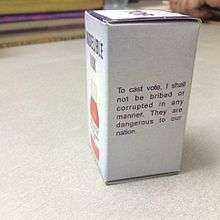
Research into an indelible ink was commenced by the Council of Scientific and Industrial Research (CSIR). In the 1950s, M. L. Goel worked on this research at the Chemical Division of the National Physical Laboratory of India. The ink used contains silver nitrate, which makes it photo-sensitive. It is stored in amber coloured plastic or brown coloured glass bottles. On application, the ink remains on the fingernail for at least two days. It may last up to a month depending upon the person's body temperature and the environment.
Electronic voting

BHAVIK (EVM) were first used in the 1997 election and became the only method of voting in 2004. The EVMs save time in reporting results. A voter-verified paper audit trail (VVPAT) was introduced on 14 August 2014 in Nagaland.[12] In the 2014 general election, VVPAT was operational in 8 constituencies (Lucknow, Gandhinagar, Bangalore South, Chennai Central, Jadavpur, Raipur, Patna Sahib and Mizoram) as a pilot project.[13][14] A slip generated by the VVPAT tells a voter to which party or candidate their vote has been given, their name, their constituency and their polling booth.[15][16][17][18][19]
Opposition parties demanded that VVPAT be made mandatory all over India due to allegations on the government of hacking the EVM. Accordingly, Voter-verified paper audit trail (VVPAT) and EVMs were used in every assembly and general election in India since 2019.[20][21] On 9 April 2019, Supreme Court of India gave the judgement, ordering the Election Commission of India to increase VVPAT slips vote count to five randomly selected EVMs per assembly constituency, which means Election Commission of India has to count VVPAT slips of 20,625 EVMs in 2019 General elections.[22][23][24] VVPAT enables voters to cross-check whether the vote they have given goes to their desired candidate as the VVPAT unit produces a paper slip, additionally called ballot slip, that contains the name, serial number, and image of the candidate selected by the voter for his vote. Post the 2019 general election, ECI declared that no mismatches between EVM and VVPAT.[25]
NOTA
On 27 September 2013, the Supreme Court of India judged that citizens have the right to a negative vote by exercising a "None of the above" (NOTA) option. This was the result of petitioning from the Electoral Commission and the People's Union for Civil Liberties from 2009. In November 2013, NOTA was introduced in five state elections.[26]
Absentee voting
India does not provide general absentee voting.[27][28][29] On 24 November 2010, the Representation of the People (Amendment) Bill 2010 was gazetted to give voting rights to non-resident Indians but a physical presence at the voting booth is still required.[30][31][32]
Postal voting
Postal voting in India is done only through the "Electronically Transmitted Postal Ballot Papers (ETPB)" system of Election Commission of India, where ballot papers are distributed to the registered eligible voters and they return the votes by post. When the counting of votes commences, these postal votes are counted before those from the Electronic Voting Machines. Only certain categories of people are eligible to register as postal voters. People working in the union armed forces and state police as well as their wives, and employees working for the Government of India who are officially posted abroad can register for the postal vote, these are also called the "Service voters". Additionally, people in preventive detention, disabled and those above the age of 80 years old can use postal vote. Prisoners can not vote at all.[33][34][35]
See also
- 49-O Now replaced with 'NOTA (None of The Above)'
- Booth capturing
- History of democracy in the Indian-subcontinent
- Election Commission of India
- Legislative Assembly elections in India
- British India - General Elections
- British India - Provincial Elections
References
- Sharma 2007, p. 31.
- "A Constitutional Body". Election Commission of India.
- "Terms of the Houses". Election Commission of India. Retrieved 19 February 2020.
- "Lok Sabha Results 1951-52". Election Commission of India. Retrieved 23 November 2014.
- "Statistical Report on Lok Sabha Elections 1951-52" (PDF). Election Commission of India. Retrieved 23 November 2014.
- "Lok Sabha Elections Stats Summary 1951-52" (PDF). Election Commission of India. Retrieved 23 November 2014.
- "Statistical Report on Lok Sabha Elections 1957". Election Commission of India.
- "Here's how BJP earned the massive mandate: Explained in numbers". The Economic Times. 28 May 2019. Retrieved 28 May 2019.
- Ramani, Srinivasan (23 May 2019). "Analysis: Highest-ever national vote share for the BJP". The Hindu. The Hindu.
- "Seventh Lok Sabha elections (1980)". Indian Express. Indian Express. 14 March 2014. Retrieved 18 October 2014.
- "Rajya Sabha Election 2017: Here Is How Members Are Elected To Upper House". NDTV.com. Retrieved 29 April 2019.
- "EC Decides to use VVPAT System at Bye-Election in Nagaland" (Press release). Press Information Bureau. 17 August 2013. Retrieved 18 August 2013.
- References:
- "EVM-paper trail introduced in 8 of 543 constituencies". dna. 27 April 2014. Retrieved 23 November 2014.
- Press Trust of India (29 April 2014). "LS polls: Voters to get 'automated-receipts' at Gandhinagar". Business Standard India. Business-standard.com. Retrieved 23 November 2014.
- Staff Reporter (4 April 2014). "VVPAT machine to be on demonstration for 10 days". The Hindu. Retrieved 23 November 2014.
- "VVPAT to be introduced in Jadavpur constituency". Indiatvnews.com. 2 April 2014. Retrieved 23 November 2014.
- Patna Sahib electorate can see who they voted for - The Times of India
- "EVM slip will help verify your vote - Times of India". Timesofindia.indiatimes.com. 28 April 2014. Retrieved 28 May 2019.
- 400 EVMs on standby for Patna Sahib, Pataliputra
- "VVPAT to Debut in B'lore South". The New Indian Express. Retrieved 23 November 2014.
- T. Ramakrishnan (April 2014). "Voter Verifiable Paper Audit Trail system comes to Chennai". The Hindu. Retrieved 23 November 2014.
- "VVPAT, a revolutionary step in voting transparency". DNA. 27 April 2014. Retrieved 27 April 2014.
- "Not many were aware of VVPAT, but were happy with verification". The Hindu. 18 April 2014. Retrieved 23 November 2014.
- "Safe distance". The Indian Express. 15 April 2014. Retrieved 23 November 2014.
- "As smooth as it gets, says city poll chief". The Times of India. Retrieved 23 November 2014.
- "Ripon Buildings turns nerve centre of electoral activities in Chennai - Times of India". The Times of India. Retrieved 13 January 2020.
- "Voter's verifiable paper audit trail system to be introduced in Chennai Central constituency". The Times of India. Archived from the original on 1 April 2014. Retrieved 3 May 2014.
- "EC announces Lok Sabha election dates: VVPATs, to be used in all polling stations, help bring more accuracy in voting". Firstpost. Retrieved 13 January 2020.
- "What are EVMs, VVPAT and how safe they are". The Times of India. 6 December 2018. Retrieved 10 January 2019.
- "Supreme Court: Count VVPAT slips of 5 booths in each assembly seat | India News - Times of India". The Times of India. Retrieved 13 January 2020.
- JAIN, MEHAL (8 April 2019). "Breaking: SC Directs ECI To Increase VVPAT Verification From One EVM To Five EVMs Per Constituency [Read Order]". www.livelaw.in. Retrieved 13 January 2020.
- "When the SC Says No for Software Audit Review of EVMs & VVPAT at Present". Moneylife NEWS & VIEWS. Retrieved 13 January 2020.
- "EVM-VVPAT pass test in Lok Sabha polls". Economic Times. 23 May 2019. Retrieved 5 June 2019.
- "ELECTION COMMISSION OF INDIA:Press release" (PDF). Eci.nic.in. Retrieved 23 November 2014.
- "Who can vote by postal ballot?". The Economic Times. Retrieved 23 November 2014.
- "Election Commission to ensure postal votes don't get invalid". dna. 7 November 2013. Retrieved 23 November 2014.
- "Pranab to become first president to cast vote via postal ballot". Oneindia.com. 29 April 2014. Retrieved 23 November 2014.
- "gazette notifications". The Hindu. Thehindu.com. 24 November 2010. Retrieved 6 August 2012.
- "Petition for Absentee Voting in Indian Elections". Voterswithoutborders.org. Archived from the original on 16 April 2009. Retrieved 6 August 2012.
- "People for Lok Satta- NRI voting campaign". Nrivotingrights.info. 9 January 2011. Archived from the original on 5 April 2011. Retrieved 6 August 2012.
- Postal ballots: Who can vote through ETPB, how to get registered and how the voting is done; an explainer, First Post, 2 April 2019.
- Maharashtra, Haryana Elections 2019: Can You Vote By Postal Ballot If You Aren't Living At Home?, Huffington Post, 26 September 2019.
- [https://www.jagranjosh.com/current-affairs/people-over-80-years-of-age-disabled-can-now-vote-through-postal-ballot-1572319857-1 People over 80 years of age, disabled can now vote through postal ballot The postal ballot facility has provided to the elderly above 80 years and disabled voters.], Jagran, 29 October 2019.
External links
| Wikimedia Commons has media related to Elections in India. |
- Election Commission of India
- Adam Carr's election archive
- Qualification and disqualification Election Commission of India handbook for candidates
